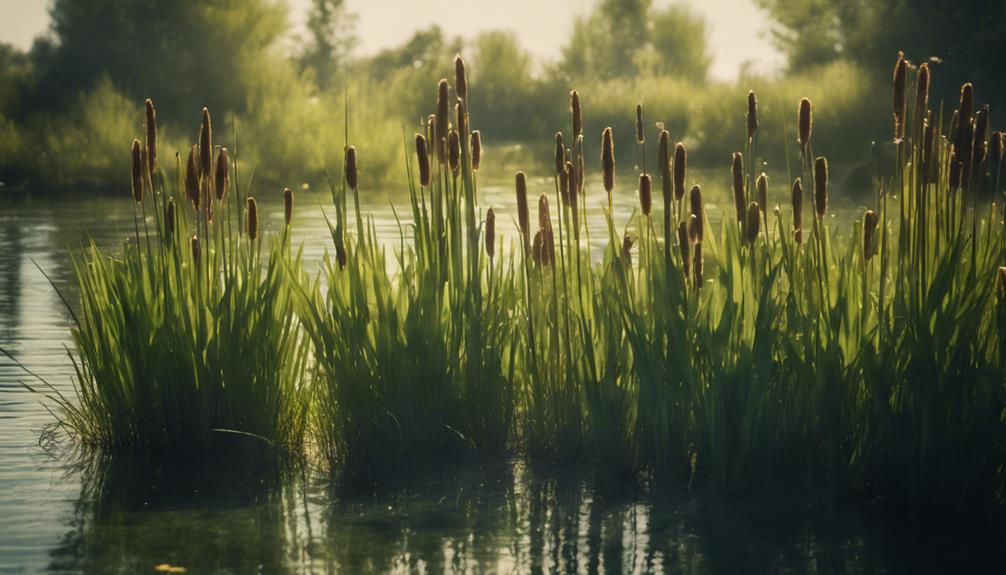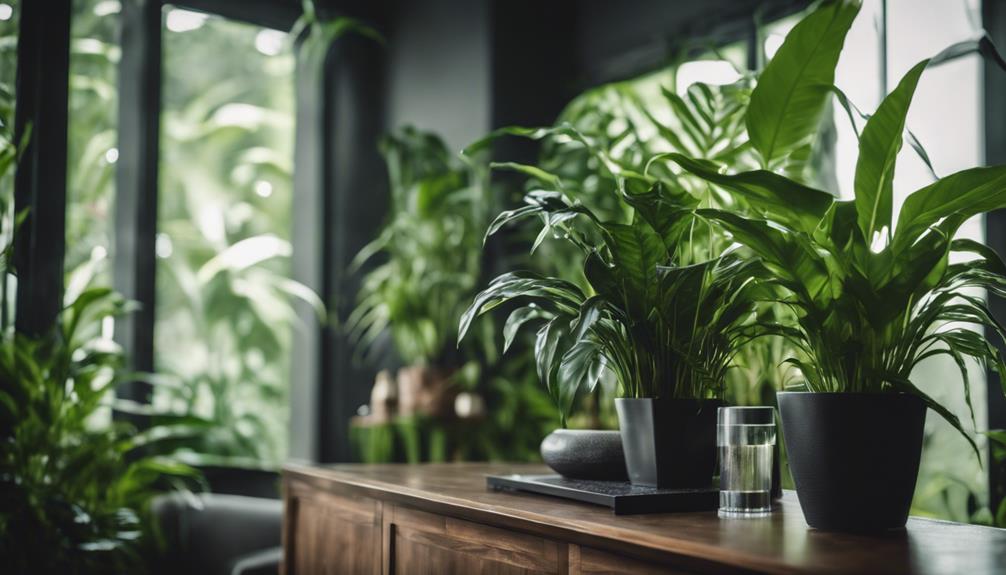You're likely aware that certain aquatic plants have been found to be incredibly effective in removing pollutants and excess nutrients from water, making them a valuable addition to your clean water filtration system. Top-performing plants include cattail, Schoenoplectus tatora (totora), water hyacinth, duckweed, and fairy moss, which efficiently absorb heavy metals, nutrients, and oxygen-demanding substances from wastewater. These plants have been shown to remove up to 99% of lead, 95% of cadmium, and 90% of phosphates, making them ideal for natural filtration systems. As you explore these options, you'll discover even more ways to harness the natural power of plants for cleaner, clearer water.
Table of Contents
Key Takeaways
- Cattail is a top choice for clean water filtration, removing metals like zinc, cadmium, lead, and nitrate from water naturally.
- Schoenoplectus tatora (totora) efficiently absorbs heavy metals like lead, silver, and copper from wastewater in less than 2 days.
- Water Hyacinth is a promising aquatic plant for wastewater treatment, removing heavy metals and other pollutants from water.
- Duckweed is highly effective, removing up to 99% of lead and 95% of cadmium from contaminated water.
- Anacharis is a submerged plant that absorbs up to 87% of nitrogen and 83% of phosphorus, making it ideal for clean water filtration systems.
Top Aquatic Plants for Filtration
When it comes to aquatic plants for filtration, you'll find that certain species stand out for their exceptional ability to remove pollutants and excess nutrients from wastewater.
In natural filtration systems, aquatic plants like cattail are commonly used to remove metals such as zinc, cadmium, lead, and nitrate from water.
Schoenoplectus tatora, or totora, is another effective aquatic plant, absorbing heavy metals like lead, silver, and copper from wastewater in less than 2 days.
Wetland treatment systems using totora have been shown to efficiently remove nutrients and oxygen-demanding substances from effluents, with impressive removal rates of 65.30% of Ammonium-N, 65.20% of Ammonia-N, and 90.20% of Nitrate-N.
Water hyacinth also appears to be a promising aquatic plant for wastewater treatment, capable of removing heavy metals and other pollutants from the water.
Effective Floating Plants for Ponds
In addition to aquatic plants, you can also harness the power of floating plants to maintain clean water in your pond, and several species stand out for their exceptional filtration capabilities.
One of the most effective floating plants for water purification is Water Hyacinth, which can absorb up to 60% of heavy metals and other pollutants from water.
Duckweed is another valuable addition to your pond's natural filtration system, capable of removing up to 99% of lead and 95% of cadmium from contaminated water.
Fairy Moss, with its delicate, carpet-like appearance, can absorb excess nutrients and pollutants, preventing algae growth and maintaining water clarity.
Water Lettuce and Floating Fern are also excellent choices, as they can absorb heavy metals, ammonia, and other pollutants, contributing to clear water and improved water clarity.
Nutrient-Absorbing Marginal Plants

By incorporating nutrient-absorbing marginal plants into your pond's ecosystem, you can effectively remove excess nutrients and pollutants from the water, creating a balanced and thriving environment.
These plants are specifically designed to absorb nutrients, heavy metals, and pollutants from the water, making them an essential component of natural filtration systems.
For instance, Water Celery can absorb up to 50% of excess nutrients, while Pickerelweed can remove up to 75% of nitrates and 90% of phosphates.
Taro, another versatile marginal plant, can absorb heavy metals like lead, copper, and zinc.
Canna, a popular choice, can remove up to 80% of nitrogen and 90% of phosphorus, notably improving water quality.
Meanwhile, Iris, with its beautiful flowers, can absorb excess nutrients and heavy metals while providing a natural barrier to prevent erosion and sedimentation.
Submerged Plants for Water Clarity
You can further enhance the water quality in your pond by incorporating submerged plants that specifically target clarity, which is where Anacharis, Hornwort, Fanwort, Watercress, and Cabomba come into play.
These submerged plants are entirely underwater and play a vital role in maintaining water clarity.
Anacharis and Watercress are fast-growing and can absorb up to 87% and 95% of nitrogen, 83% and 85% of phosphorus, respectively, from the water, making them highly effective in removing excess nutrients that contribute to algae growth.
Hornwort, on the other hand, is a low-maintenance option that can absorb heavy metals and provide a habitat for beneficial bacteria.
Fanwort and Cabomba are also effective in absorbing excess nutrients, reducing algae growth, and improving water clarity.
By incorporating these submerged plants into your pond, you can oxygenate the water, reduce algae growth, and maintain ideal water clarity.
With the right combination of submerged plants, you can create a thriving ecosystem that supports aquatic life and maintains pristine water quality.
Natural Algae Controllers for Ponds

Your pond's ecosystem can benefit substantially from natural algae controllers, which effectively outcompete algae for resources, reducing their growth and promoting a balanced environment.
As a pond owner, you can utilize specific pond plants to control algae growth and maintain clean water. These plants play a vital role in removing excess nutrients from the water, thereby preventing algae blooms.
Water lilies, for instance, are excellent natural algae controllers. They help to shade the surface of the water, reducing the amount of sunlight available for algae growth. Additionally, they absorb excess nutrients, preventing them from fueling algae blooms.
By incorporating these plants into your pond's ecosystem, you can enjoy clean water and a balanced environment. As plants remove excess nutrients, they promote the growth of beneficial bacteria, which further aid in maintaining clean water.
Frequently Asked Questions
What Plants Are Good for Water Filtration?
When selecting plants for water filtration, you'll want to choose aquatic species that excel in water absorption, utilizing effective filtration methods to improve water quality, ideal for green infrastructure in urban systems, rainwater harvesting, and water conservation.
What Plants Clean Polluted Water?
Can you imagine a world where polluted aquifers and water scarcity are a thing of the past? You can harness the power of plants like water hyacinth, totora, and mosses to remove chemical contaminants, treat wastewater, and restore ecosystems, ensuring freshwater sources for all.
Which Plants Prefer Filtered Water?
You'll find that Filtered Favorites, like Water Lovers, have Pure Prefs for Clean Cravings, requiring Refined Roots to thrive in Purified Picks, making them Fresh Fans of Clear Choices, and ultimately, Purely Picky about their water quality.
What Herbs Are Good for Cleaning Water?
As you set out on a journey to find the perfect water purifiers, you'll discover herbs like lemongrass, basil, and mint, which serve as natural antiseptics, infusing fresh flavors and aromatic properties into your water, while also boasting medicinal values and spiritual significance.
Conclusion
As you consider implementing a clean water filtration system, remember that the right plants can make all the difference.
By incorporating top aquatic plants like water wisteria, effective floating plants like water lettuce, nutrient-absorbing marginal plants like cattails, submerged plants like anacharis, and natural algae controllers like hornwort, you'll be well on your way to crystal-clear water.
But the question remains: what other secrets do these plants hold, and how can you tap their full potential for a pristine aquatic environment?

